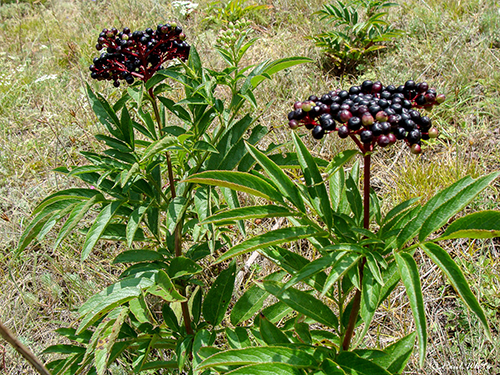Contents
Dwarf elderberries are toxic, so be careful not to mistake them for black elderberries. Both plants belong to the same botanical family and have similar uses, though the black elder is more widely used because of its more tolerable smell.

Dwarf Elder Scientific Facts
- Other names are Blood Elder, danewort, walewort, and Wild Elder.
- French – Hieble.
- Spanish – Yezgo.
- Environment – Spread along forest borders and excellent fields throughout Europe and naturalized to America.
- Description—A vigorous plant of the Caprifoliaceae family with a disgusting odor, it has an upright stem that grows up to 1.5 m high. Its flowers are small and white and grow in umbels. The fruit are blackberries that appear in upgrowing clusters.
- Parts of the plant used medicinally – The root and the leaves.
Healing Properties

The whole plant contains glycosides, essential oil, tannin, and saponin. It has strong sudorific, diuretic, and laxative properties, and therefore it is used as:
- Diuretic – for edema (retention of fluid in tissues) or renal insufficiency.
- Sudorific – for febrile afflictions (colds, influenza, malaria, etc.).
- Antirheumatic – a decoction or alcoholic extract of dwarf elder is externally applied as compresses or massage to ease rheumatic aches.
- Insect repellent – fresh dwarf elder leaves, or their decoction, sprayed, repel mosquitoes.

WARNING! Never exceed the recommended doses of root or leaves. Its berries are incredibly toxic.
How to use Dwarf Elder
- Decoction with 30 g of leaves and/or root per liter of water. Boil for 5-10 minutes. Drink up to three cups daily.
- Compresses soaked in a decoction similar to the one mentioned above can also be soaked in dwarf elder alcoholic extract.
- Massage with this decoction or the alcoholic extract.
DISCLAIMER: All content on this website is presented solely for educational and informational objectives. Do not rely on the information provided as a replacement for advice, diagnosis, or treatment from a qualified medical expert. If you are pregnant, nursing, or have any preexisting medical concerns, talk to your doctor before using any herbal or natural medicines.
REFERENCES
- George D. Pamplona-Roger, M.D. “Encyclopedia of Medicinal Plants.” George D. Pamplona-Roger, M.D. Encyclopedia of Medicinal Plants. Ed. Francesc X. Gelabert. vols. 2 San Fernando de Henares: Editorial Safeliz, 2000. 590. Print.
- WebMD: https://www.webmd.com/vitamins/ai/ingredientmono-427/dwarf-elder
- RxList: https://www.rxlist.com/supplements/dwarf_elder.htm
